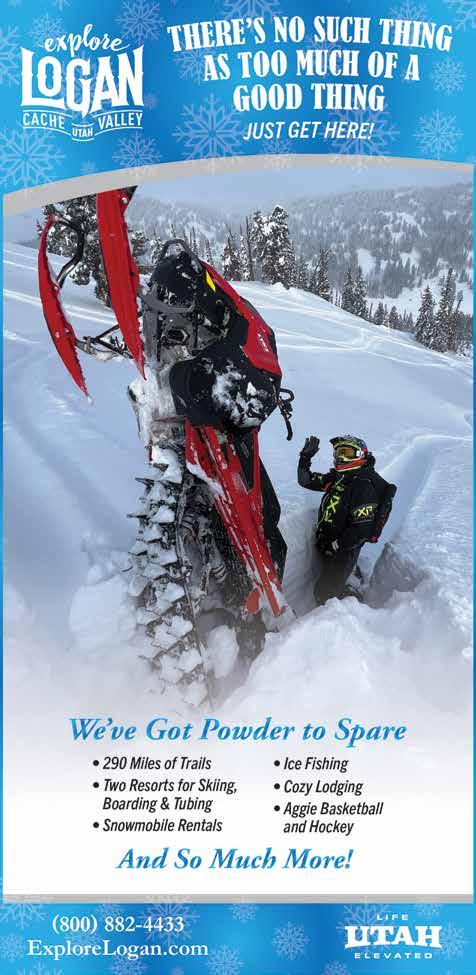








Winter is magical in southern Utah. Come hike Kanab’s snowy red rocks, tour Best Friends Animal Sanctuary, and enjoy a very warm welcome at Best Friends Roadhouse & Mercantile for both you and your pet. Don’t have a pet? We’re happy to arrange a sleepover with a Sanctuary dog, cat or bunny!

Best of State Utah Awards Best Motel, 2022 & 2023


Book your stay at bestfriendsroadhouse.org or 435-644-3400.




Best of the Best in Hospitality, 2023






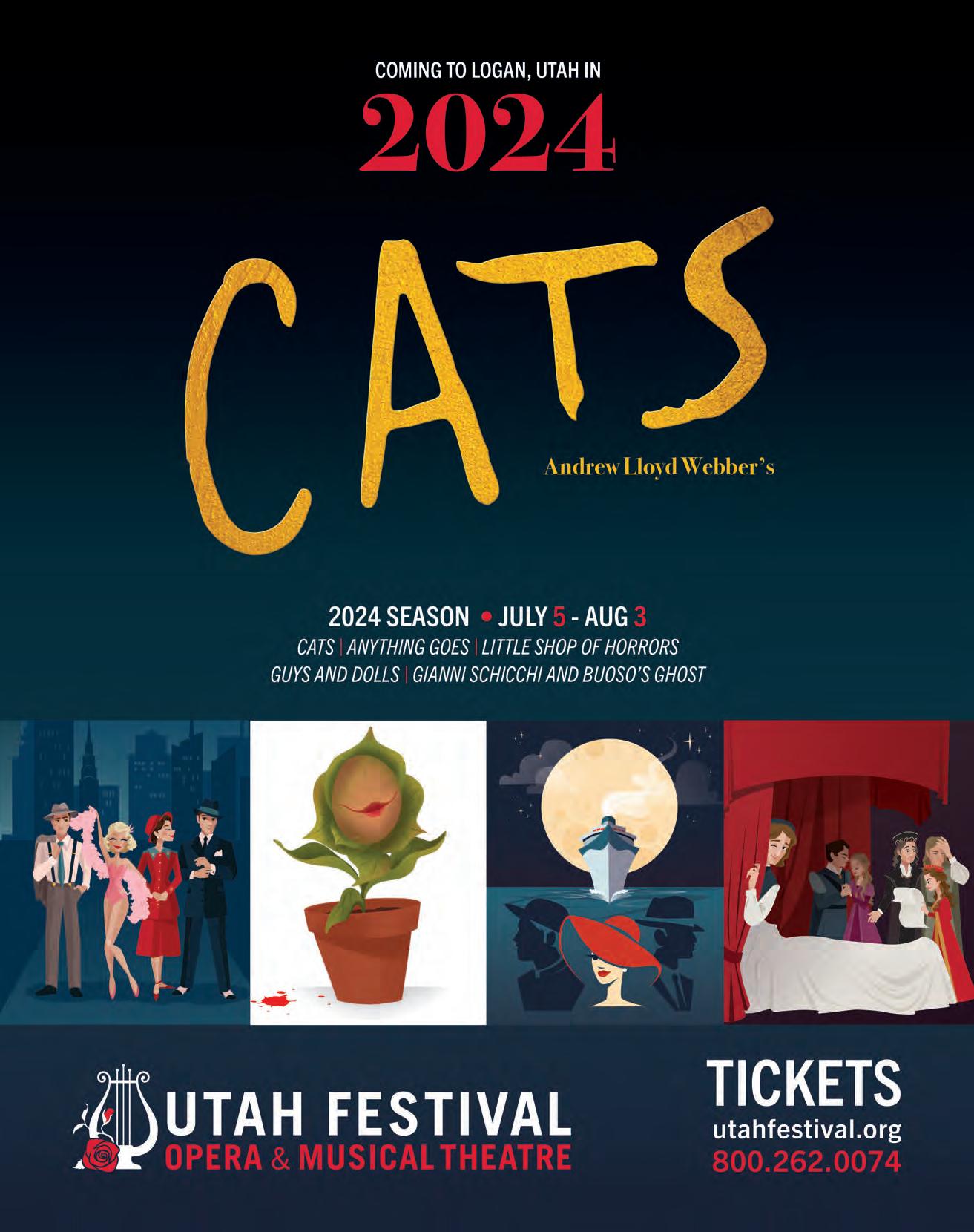

Salt Lake City, pg. 40 Alta, pg. 11
Heber City, pg. 34

Panguich, pg. 44 Cedar City, pg. 20

Icicles frame The Organ in Arches National Park at Moab. Story begins on page 20.
Photo by Jeff Foote
Moab, pg. 20
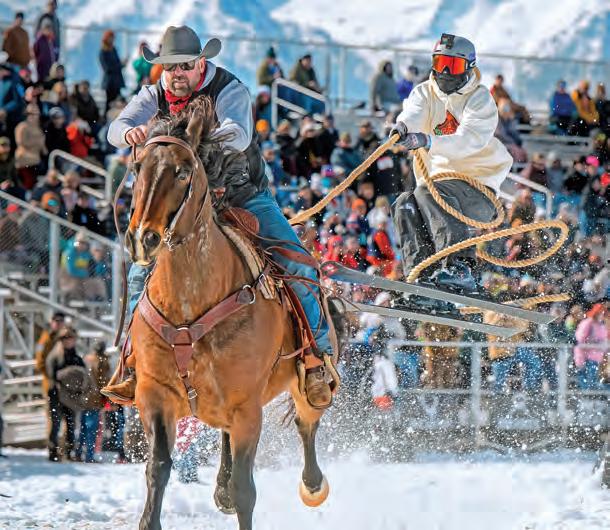
Generations of travelers find respite at this historic civilian fort near Beaver. Story and photographs by Joshua Hardin
Photographer Jeff Foote chronicles the striking juxtaposition of desert ice in southern Utah. Photographs by Jeff Foote Stor y by Tom Hess
Cowboys and ski bums unite in Heber City’s skijoring competition – part rodeo, part ski racing, and 100 percent wild west spectacle. By Colin Clancy


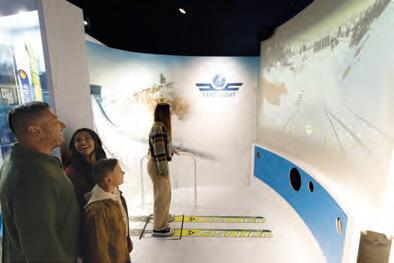
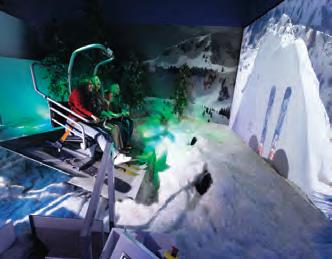





CERTAIN TOOLS HAVE been essential for exploring Utah since the fur trappers began arriving in the 1830s, bringing with them Dutch ovens they seasoned with grizzly bear grease.
Today, a camp stove is essential for exploring Utah’s wilderness when you intend to stay awhile. Alta-based photographer Noah Wetzel uses his camp stove to cook veggie dogs on long trips in the winter, rising before sun-up and retiring after dark. Those days reward him, and us, when he returns with stunning white-snow-onred-rock images like the one on page 44, our “Monumental Exposure” contest.
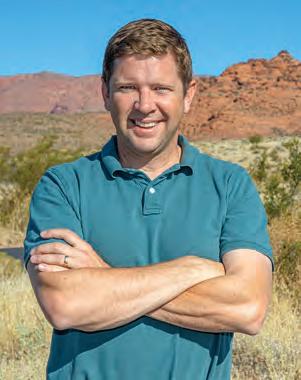
For Castle Valley photographer Jeff Foott, a hardhat is essential equipment when he’s ducking his head and camera under giant icicles in our national parks. He brings back shots like our cover and “The Ice Show” photo essay that follows.
Poles are essential for most skiers, but for skijoring competitors, a thick cotton rope behind a mighty steed is all they need to go fast and fall hard. Salt Lake City writer, photographer and sometimes-skijorer Colin Clancy makes his Utah Life debut with a story about the rough-and-tumble world of competitive skijoring.
On the finer side of life, Colin also shares a story about Alta-based artist Lexi Dowdall for whom snow is the an essential tool in creating her new series of paintings about our iconic ski resorts.
While photographers like Noah and Jeff likely would disagree with me, the most essential piece of equipment to have on hand while exploring Utah certainly is a notebook. How else could you possibly capture what the late author and Arches National Park ranger Edward Abbey wrote: “There’s beauty, heartbreaking beauty, everywhere”? I’ll leave it to our poets and their notebooks to answer that question.
Speaking to the creatives who love Utah, whatever your essential tool, I’d like to see what you create when our state inspires you. Send me your photos, stories, essays and poems. You can reach me by email (another essential tool) at editor@ utahlifemag.com.
And if your creativity happens in the kitchen and you produce an exceptional Utah recipe with a good story behind it, send that, too. You might persuade our friend Noah to swap his camp stove for a Dutch oven seasoned with bear grease.
CHRIS AMUNDSON Publisher & Editor editor@utahlifemag.com
Winter 2024
Volume 7, Number 1
Publisher & Editor
Chris Amundson
Associate Publisher
Angela Amundson
Creative Director
Darren Smith
Senior Editor
Tom Hess
Photography Coordinator
Amber Kissner
Production Assistant
Victoria Finlayson
Advertising Sales
Marilyn Koponen, Katie Shannon
Subscription Services
Carol Butler, Janice Sudbeck
c/o Subscriptions Dept. PO Box 270130 Fort Collins, CO 80527 (801) 921-4585
UtahLifeMag.com
Subscriptions are $30 for 6 issues and $52 for 12 issues. To subscribe and renew, visit UtahLifeMag.com or call (801) 921-4585. For group subscription rates, call or email publisher@utahlifemag.com.
Send us your letters to the editor, story and photo submissions, story tips, recipes and poems to editor@utahlifemag.com, or visit UtahLifeMag.com/contribute.
For rates, deadlines and position availability, call or email advertising@utahlifemag.com.
All text, photography and artwork is copyright 2024 by Flagship Publishing, Inc. For reprint permission, please call or email publisher@utahlifemag.com.

by BRANDI CHRISTOFFERSEN
As families settled in the northwestern Utah town of Garden City, they were charmed by the pristine, turquoise blue waters of Bear Lake, and later shocked to hear native tribes speak of a serpent-type monster with a large menacing mouth lurking below the lake’s surface.
Soon after the settlers’ arrival, they began reporting sightings of the creature.
Reports of the monster became so fre-
quent that in 1876, a local resident, Phineas C Cook, devised a trap to capture the beast – mutton on a hook, a buoy and a 300-foot rope attached to a tree. Second President of The Church of Latter-Day Saints, Brigham Young had visited the lake a few years earlier. Convinced that the sightings were legitimate, he provided the rope, and hoped to see the beast captured. Cook later found the mutton missing, but no beast.
As the years passed, the sightings continued, but with less frequency. In the most
recent report in 2002, a business owner said he saw a creature with two humps, slimy green skin and deep red eyes in Bear Lake. Today, amateur seekers rent boats or jet skis and explore the 110-square-mile lake for evidence of the monster’s existence. The bright side is, even if you don’t find the brute, there are plenty of water sports and activities to make the trip worthwhile.
Bear Lake in Rich County is thought to be home to a creature that evaded a trap set with mutton.
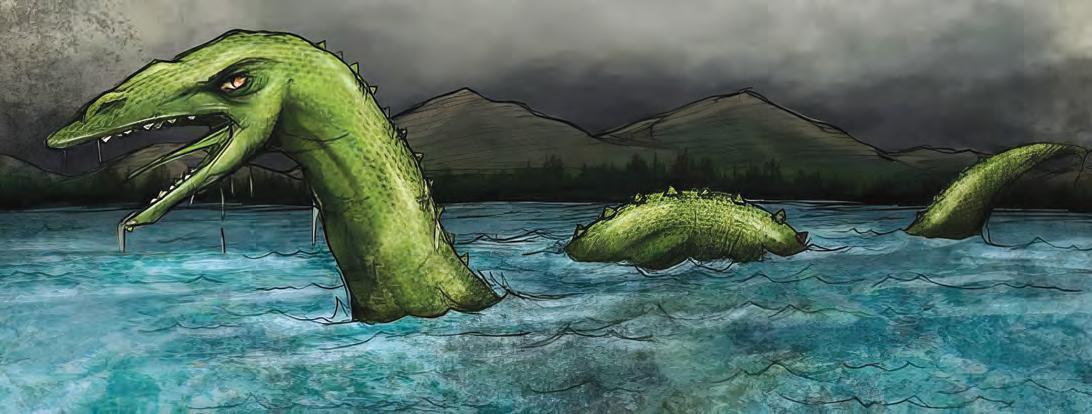

‘Pioneer
by JOSHUA HARDIN
Scaffolding has lifted from the gleaming white towers of a magnificent first-of-its-kind building set amongst the red-rock palisades surrounding St. George.
The St. George Temple is The Church of Jesus Christ of Latter-Day Saints’ longest-operating Utah temple and was the first completed of 28 in the state. Dedicated in 1877 by Church President Brigham Young, it was the only temple finished during his 30-year tenure as Church president. The temple had been closed since November 2019 as part of an effort to renovate pioneer-era temples which currently also includes those in Manti and Salt Lake City.
A rededication was held December 2023, following a nine-week open house. Benjamin Pykles, director of the Church History Department’s Historic Sites Division, remarked during a media preview that the temple has been restored in a way honoring the original builders.
“It feels special and it feels beautiful, but it also feels historic. It still feels like a pio-
neer temple,” he said. “All of the furnishings and the lighting fixtures, the carpets, the furniture, all of those are intentionally designed ... to reflect the period that the temple was built.”
While much of the original artwork, furniture, fabric and other details from the temple have been lost, restorers added wood flooring, carpet and tile similar to historic designs. In addition to needed mechanical, plumbing and electrical updates, renovators added a bride’s room exit, baptistry entrance, and commissioned new murals depicting the natural beauty of the southwest Utah landscape.
Improvements to the grounds included replacing a quatrefoil-shaped fountain from a 1975 renovation, adding a new fountain and planting 250 trees.
The site is unusually swampy for its desert environment, as such the temple’s original builders took great care to lay the foundation. After packing the
site with lava rock using a cannon as a pile driver, they laid large, locally-quarried basalt blocks in the foundation and built exterior walls from red sandstone. Skilled craftsmen used wood from Mt. Trumbull, Arizona for other flourishes.
Originally patterned after temples in Kirtland, Ohio and Nauvoo, Illinois, the St. George Temple provides sacred ordinances in Church worship that bind followers to Jesus Christ and together as families. In early years, Church members nicknamed a road between communities in Arizona and St. George “the Honeymoon Trail” because many traveled weeks by wagon on rough roads to be sealed as husband and wife and participate in other temple ordinances.
Elder Erich W. Kopischke, a General Authority Seventy of the Church, marvels how builders persevered despite not having paved roads, electricity or railroad access.
“That tells me something about the pioneers – their spirit, their devotion, their consecration,” he said. “I’m touched by that. I want to follow their example.”
St. George had approximately 1,100 residents at the time of the temple’s first dedication. The temple has been renovated more than 10 times since as the community continued to grow. Now, nearly 150 years after the temple opened, the city’s population is more than 100,000. The temple’s newest renovation promises to help to keep it serving for many years to come.


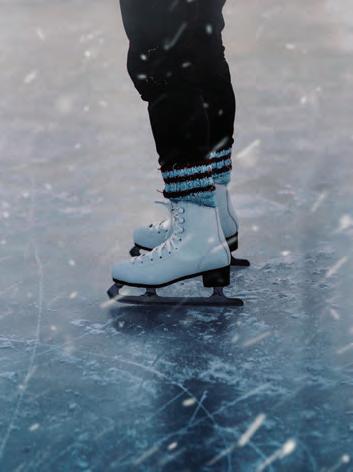





by COLIN CLANCY
Ahundred inches of snow fell on Alta Ski Area over four days in February 2021, a record-setting storm. Lexi Dowdall watched out the window, wanting to ski it, but that would have been illegal. The town of Alta prevented people from venturing outdoors while ski patrol mitigated the avalanche risk.
When the storm cleared and the travel ban was lifted, Dowdall rushed to Alf’s High Rustler and scooped up snow in a water bottle as a memento. That snow was the start of her “Paint by Powder” project, in which she’s painting iconic scenes from each of Utah’s 15 ski resorts, incorporating into her watercolors snowmelt she collected from each mountain.
Her Snowbird piece is her personal favorite, portraying the iconic Snowbird

Lexi Dowdall took a sample of snow from Sundance Resort, then mixed it with watercolors, and used the mixture to paint “Sundance,” the first in a series of ski-resort paintings she calls “Paint by Powder.” RE WIKSTROM
tram pre-dawn from above the Cirque.
“When I’m painting a landscape, I want you to connect with that place,” she said, “and I feel like using the elements of that place creates a more tangible connection.”
As a fifth-generation Utahn, Dowdall grew up experiencing the outdoors – from red rock to river gorges. The high alpine of Little Cottonwood Canyon is where she feels that connection most. Her dad worked in the medical clinic at Snowbird. “He would take my little sister and me to work and kick us out the door,” she said. “Snowbird was essentially daycare.”
She learned to draw and paint from her sculptor and painter grandmother. Always drawing, Dowdall earned the nickname “Doodle” from her school classmates, a play on her surname. On a 2019 raft trip down the Green River through the Gates of Lodore, she packed a small watercolor
kit on a whim, and that strengthened her interest in painting.
She has since developed a loyal following among the ski and outdoor crowd of Salt Lake City and beyond. In 2020, she launched her website, kapowder.com, and sold her work at local markets and events.
Working as a freelancer writer and filmmaker in the ski industry has sent her all over the world: Canada, Austria, Switzerland, Japan. But she’s always excited to be home in Utah.
Dowdall is two-thirds of the way through her “Paint by Powder” project, with five paintings to go. She plans to complete it in the spring and move on to her next big project: experimenting with water from the Great Salt Lake.
Find originals and prints of Lexi’s paintings at her website kapowder.com.











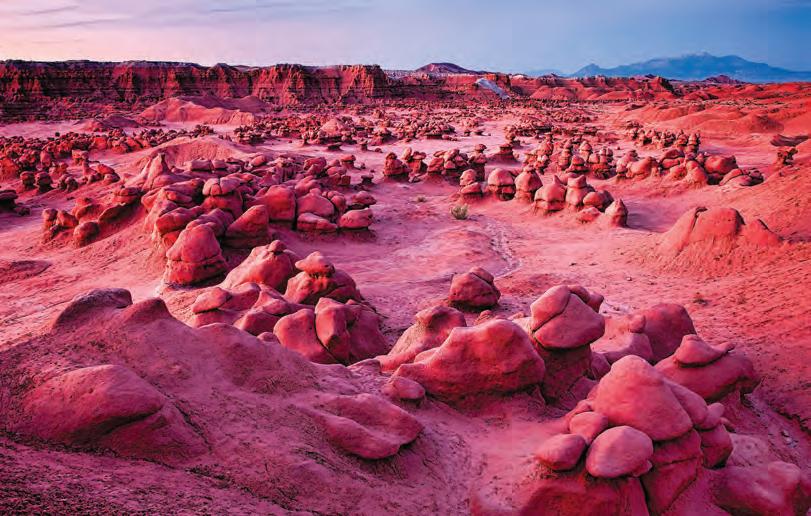

1 Tim Allen, Alan Rickman, Justin Long, and Sigourney Weaver star in the 1999 film Galaxy Quest in which their spaceship –Protector – becomes damaged, forcing them to a nearby planet to pick up a power source. The scene from this planet – Epsilon Gorniar II – was filmed at which southern Utah state park?
2
Horror filmmaker Ari Aster’s first claim to fame was shot in different locations across Utah including a luxury Park City home and scenes filmed inside of West High School. What was the name of this movie, released in the summer of 2018 by A24 Films?
3
You can watch Kevin Bacon kick off his Sunday shoes in the iconic 1980’s film Footloose, set in the fictional town of Bomont. In which Utah city did most of the filming take place?
4
In the movie Forrest Gump, the titular character finishes a crosscountry marathon in southern Utah
near the Arizona border when he decides: “I’m pretty tired … I think I’ll go home now.” This scene takes place in which Utah state park?
5
The school used in the movie High School Musical still keeps the iconic pink locker of Sharpay Evans for student use. Name the Salt Lake City high school where the movie was filmed.

6
In the 1993 movie The Sandlot, the rambunctious character Micheal “Squints” Palledorous fakes drowning to receive mouth-to-mouth resuscitation from Wendy Peffercorn. This scene was shot at Lorin Farr Community Pool in which Utah city?
a. Ogden
b. Lehi
c. Midvale
7 The Disney Channel Original Movies Halloweentown High and Luck of the Irish contain scenes filmed at which Utah high school?
a. Corner Canyon High School
b. Jordan High School
c. Juan Diego Catholic High School
8 Which of the following winners of Sundance Film Festival awards did not have any filming take place in Utah?
a. Brigsby Bear
b. The Blair Witch Project
c. Napoleon Dynamite
9 Popular scenes from Footloose took place at this historic flour mill that is also known as an early supplier for Kentucky Fried Chicken.
a. Bob’s Red Mill
b. Lehi Roller Mill
c. Salt Lake Milling Co.
10 Andrew Garfield stars in the Hulu miniseries adaptation of Jon Krakauer’s Under the Banner of Heaven. Based on a true Utah story, the filming of this series actually took place in Canada. In which province did most of the filming take place?
a. Alberta
b. British Columbia
c. Ontario

11
In the first and second seasons of the hit series Yellowstone, scenes supposedly showing Bozeman, Montana were actually filmed in Ogden, Utah.
12
The 1991 film Thelma & Louise is often cited as a controversial film with feminist overtones. The filming of the main character’s road trip was completed on highways between Arkansas and the Grand Canyon.
13
Scenes of Tatooine (a fictional desert planet) in Star Wars Episode IV: A New Hope were filmed in the desert near Arches National Park.
14
In the 2000 film adaptation of Dr. Seuss’ How the Grinch Stole Christmas starring Jim Carrey, Solitude Mountain Resort provided the wintery backdrop of powdery peaks for the Grinch’s scheming.
15
127 Hours starring James Franco depicts the real-life story of Aron Ralston, who spent 127 hours stranded and trapped after a climbing accident in a remote slot canyon in Zion National Park.

story and photographs by JOSHUA HARDIN
COVE FORT HAS always been more than an average rest stop. Now 157 years old, this volcanic rock outpost near the Interstate 15/70 junction outside of Beaver has its roots in a time of conflict. Yet, through the years, it has proven itself to be a place of peace and comfort, with only one bullet ever being fired toward another human being.
The fort was constructed on the Mormon Corridor – an array of roads and trails branching out between Salt Lake City, St. George and settlements beyond. Merchants, farmers and religious pioneers sought safe haven and warm meals here at what is now Utah’s only remaining civilian frontier fort.
Automobiles and semi-trailer trucks whiz down the super highways. Volcanic hillsides descend to a tree-lined valley where Cove Fort abides the ages. Its thick outer walls and wagon-size wooden doors loom large, but not as big as the smiles on the friendly faces of the tour guides inside.
Louise Crosby and husband Richard Crosby served as a senior missionary couple in the St. George Temple of The Church of Jesus Christ of Latter-day Saints. They received a serendipitous – and some might say “inspired” – phone call asking them to move to the fort, which is a Church-owned historic site,
“I was thrilled,” Louise Crosby said. “Cove Fort is special to our family.”
The fort has been part of her family’s heritage going back four generations: Her great-grandfather Ira Hinckley was the fort’s builder and first caretaker.
ON APRIL 12, 1867, Church President Brigham Young sent a letter to Hinckley, who was a blacksmith in Coalville. The call was not unlike the call Louise and Richard received. Young asked Hinckley to move and construct a new fort near Cove Creek. Like his great-granddaughter, Hinckley obliged without hesitation.
The fashions are different today, but Cove Fort’s walls of volcanic rock look the same as when they were first built.
UTAH STATE HISTORICAL SOCIETY


He seemed proud of having the distinction of being the only person ever shot at the fort.
Hinckley was an early Church member and had lived in Nauvoo, Illinois, but violence there compelled Hinckley to migrate west.
“We wish to get a good and suitable person to settle and take charge. A man of sound practical judgment and experience. Your name has been suggested,” Young wrote to Hinckley. “The object of building a fort is to afford protection to the telegraph and mail stations and to travelers who are almost constantly on the road.”
A man of action and not a letter writer, Hinckley simply requested the courier say to Young that he would “be there on the appointed day with conveyance prepared to go.” He left Coalville five days later and traveled 220 miles to the proposed fort’s location.
Early expeditions into Southern Utah sent by Young marked Cove Creek as an ideal spot for a future community as early as 1849. The creek didn’t supply enough water to sustain a large settlement, so towns eventually sprang up in other spots. Nevertheless, settlers increasingly ventured through the area because it was a convenient place to camp along the trail between the territorial capitol of Fillmore and the closest town to the south, Beaver.
Charles and Eleanor Willden were the first settlers who attempted to put down roots in the Cove Creek crossroads. After completing a Church mission in Cedar City in 1859, the Willdens purchased 160 acres and built an adobe house encircled by a cedar post stockade. This ranch became a de facto fort for travelers seeking refuge from the location’s unpredictable weather conditions.
AS THE MORMON Corridor of settlements stretching from Idaho to Nevada expanded farther south through Utah, conflict escalated between the new pioneers and the American Indians who already inhabited the area. A failed negotiation over the killing of 15 head of cattle led to a series of raids led by Ute Chief Black Hawk across the region, some of which targeted the Willden homestead in 1865. The Willdens moved to Beaver after narrowly surviving the attacks but sustaining heavy losses to their livestock. They abandoned Fort Willden, leaving travelers without a sanctuary from Ute warriors or severe weather.
craftsmen from nearby settlements to survey and build the fort when he arrived in 1867. From April to November, workers constructed the fort from volcanic rock quarried from surrounding mountains. Head stonemason Nicholas Paul used his personal formula for cementing the rocks with a lime mortar that has held the walls together through the ages. The team plotted the fort with walls 100 feet long, 18 feet high and 4 feet thick, with an arched 14-foot square gateway on the east end.
The plan included 12 rooms, half of them bedrooms for residents and lodging for guests, and the other half public rooms, including the kitchen and dining area. Each room had a chimney. Laborers used locally sourced lumber, mostly juniper and pine, for the roof and doors.

Outbuildings included one of the largest barns in Utah at the time, a bunkhouse and a blacksmith shop. A stagecoach company owned and boarded stock in the barn, where hired hands groomed and fed fresh horse teams for the twice-daily stagecoaches that cycled through the fort. Postal express riders kept fast horses for a roughly 60-hour stretch delivering mail to Cedar City. Modern restorers built a 30-foot-high, 60-by-60foot replica of the barn near its previous location, and they believe the blacksmith shop’s bellows currently on display originally belonged to Hinckley.
AFTER THE FORT was completed, Ira called for his wife Adelaide and seven children. Several months later, Ira brought another wife, Angeline, and children including a 4-month-old son, Bryant S. Hinckley, who would be the father of future Church President Gordon B. Hinckley. The family immediately began adding interior touches
A constant stream of miners, traders and migrants shared conversation and prayers with the Hinckley family at their dinner table each evening. A clicking telegraph kept the fort throbbing with national news. In addition to blacksmithing, Ira ranched hundreds of head of cattle divided into Perpetual Emigration Fund, tithing and personal herds. Adelaide earned the nickname “the good mother of the road” due to the delicious meals she provided for guests.
Hinckley, with help from his brother Arza, gathered
Elizabeth Kane, a guest traveling with her husband, Thomas – a Civil War general and friend to Young – wrote
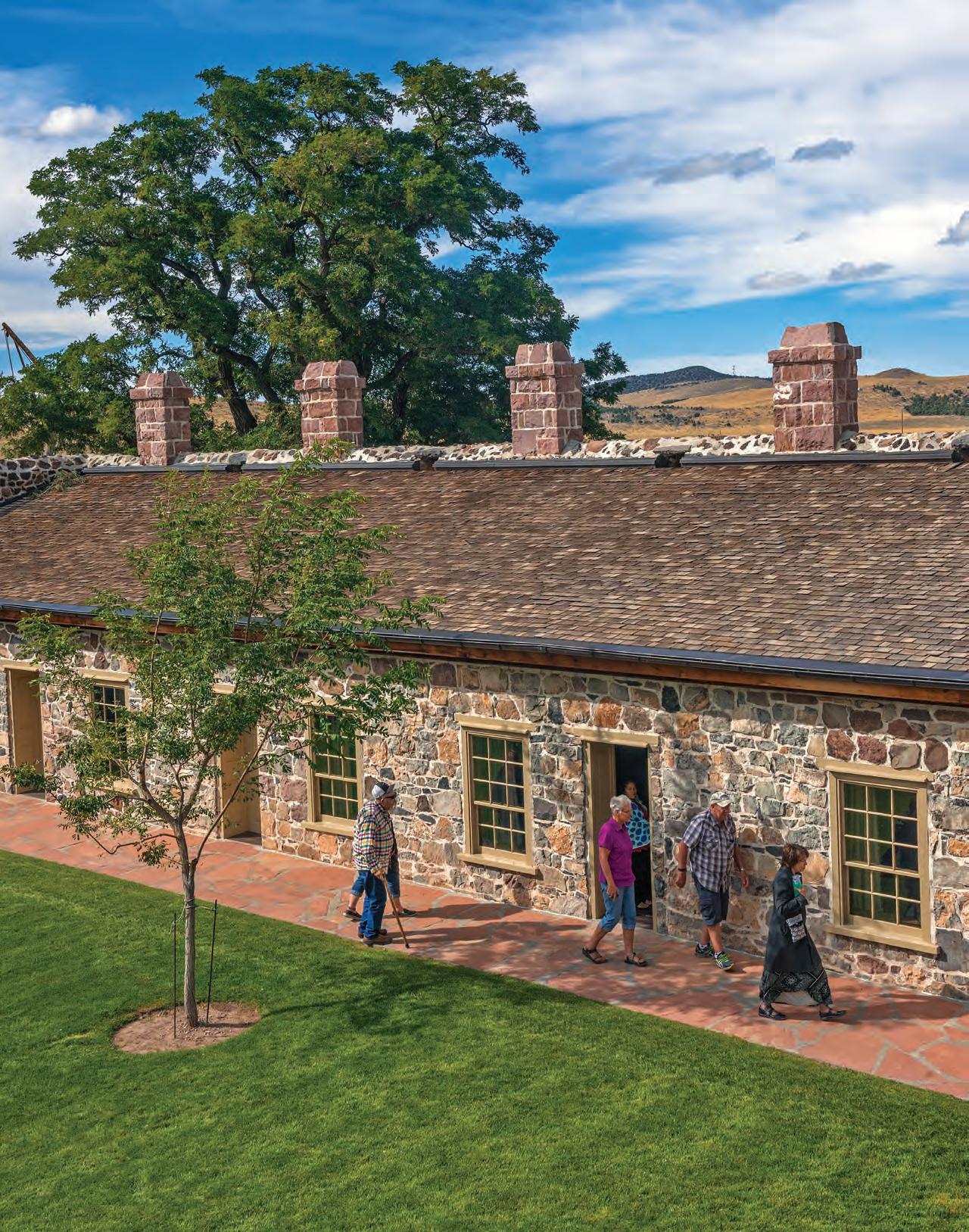


that she “marveled at the presence of such dainties in that inhospitable looking spot” after encountering the kitchen’s fine tableware and homey bedrooms with well-stocked book collections.
Resident children had plenty of chores to occupy their time. They farmed gardens behind the fort, cared for livestock and foraged neighboring hills for berries, roots and other foodstuffs. Children most enjoyed the excitement of watching from a nearby field of grass as stagecoaches arrived at the fort.
Despite having been built to protect travelers from the threat of Indian attacks, gun ports carved into the walls went unused. The rampages of the Black Hawk War had subsided, and there never was a battle waged at the fort. Still, at least one person was shot at Cove Fort.
Hinckley’s sons, 9-year-old Bryant and 8-year-old Ed, once found a pistol in their parents’ room. They showed it to a preoccupied baby-sitting telegraph operator, who examined the gun and assured them it was unloaded. However, the brothers went back to their parents’ room, where Ed pulled the trigger and accidentally shot Bryant in the knee. Bryant recalled his father walked the floor with him later that night to soothe the pain. Doctors couldn’t remove the bullet, but Bryant recovered quickly. For the rest of his life, he seemed proud of having the distinction of being the only person ever shot at the fort.
The Hinckleys managed the fort for more than 20 years,
“Hunger was satisfied here, wounds were dressed, comfort and hope were spoken, and there was prayer.” – CHURCH PRESIDENT GORDON B. HINCKLEY
until the family moved to Fillmore and Ira began serving as Millard Stake President. In the early 1890s, the Church determined the fort was no longer necessary and leased it out, eventually selling it to the William Henry Kesler family, which had resided there for seven years. It was a fortunate choice. Four generations of Keslers maintained the fort for most of the 20th century, operating a motel, picnic area and gas station as the rate of visitors accelerated with advent of the automobile. Cove Fort likely would have disappeared from today’s landscape, as other Church of Jesus Christ frontier forts in Utah have, without the Keslers’ custodianship.
Louise Crosby’s parents, Arza and Erma Hinckley, headed an effort to reacquire the fort in 1988 – when they were both nearly 80 years old.
They solicited Hinckley descendants for money to purchase the fort and organized a cleanup process that enlisted seven children and grandchildren to spruce up the site while they stayed in trailers nearby that summer. Less than a year later, the Hinckleys donated the fort back to the Church, which made further repairs, transported Ira’s Coalville cabin to the site, constructed a visitor center and reopened it to the public.
Ira’s grandson President Gordon B. Hinckley dedicated the restored fort on May 21, 1994, saluting his ancestors as men and women of refinement who cultivated the better elements of life in the desert.

time to see and learn more of the fort,” Louise Crosby said. Cove Fort got a bit of national attention in 2004, when the Federal Highway Administration placed a sign in Baltimore, I-70’s eastern terminus, listing “Cove Fort, 2,200 miles.” The sign was supposed to test the legibility of a new typeface for road signs, and the test apparently was a success. The department received a surge of questions about Cove Fort, prompting a series of Baltimore-area media reports about the Western outpost. Some people in both Utah and Maryland hope the Utah Department of Transportation will reciprocate by placing a sign at Cove Fort listing the distance to Baltimore.
The Crosbys have seen at least two people who were inspired by the signs to travel cross-country from Baltimore and post accounts of their journey on Facebook, but that represents a small fraction of the estimated 2 million visitors the fort has welcomed. The fort regularily attracts more than 70,000 visitors a year. Missionaries provide free, hour-long guided tours year-round from 11 a.m. to 5 p.m. Monday through Saturday, and 12 p.m. to 5 p.m. Sunday.
Resident children farmed Cove Fort’s gardens and cared for livestock. The fort knew peace; gun ports in the walls went unused.
“This place was constructed to provide safety and rest, nourishment and comfort,” Hinckley said. “It was operated by good Samaritans who gave succor to those in need. Hunger was satisfied here, wounds were dressed, comfort and hope were spoken, and there was prayer. Gratitude was expressed for the gift of life.”
The Hinckley family brought another gift – an heirloom clock thought to have been originally present during the fort’s operating days. It is displayed atop a fireplace mantle in the nursery bedroom as a sign of the family’s seemingly timeless link to the site.
AS THE CLOSEST community to I-70’s western terminus, the fort is intriguing to history buffs and curious motorists, yet many people don’t stop because they don’t realize it’s only about one mile away from the interstate.
“I can’t tell you how often a visitor will say that they’ve driven by a hundred times but were impressed to stop on that particular day, and how glad they were that they took the
Senior couples like the Crosbys have the option to serve missions of 12 or 18 months. Approximately nine couples serve during the busiest season of March to November. This year they are organizing a celebration to commemorate the 30year anniversary of the dedication of the site. Festivities will take place the last week of May.
For Louise Crosby, every day is a chance to share the “sweet spirit” that still lingers from the sacrifices of all who served at the fort. Her tours have a personal quality. She loves seeing children’s faces as she tells them the cautionary story of how Bryant miraculously survived being accidentally shot by his brother. She shows visitors the parents’ room where her father took her when she was a little girl, pointed inside and said it was the place her grandfather was born.
“Cove Fort is part of who we are, and we are a part of it,” she said. “Though unexpected, this call was positively providential. It’s a tender mercy that’s been a blessing to my life.”
This article was originally published in the March/April 2018 issue of Utah Life. Louise and Richard Crosby were released from their missionary service in 2019. Louise Crosby passed away in 2023 in St. George.

One photographer’s courageous winter journeys are a gift to future generations


APhotographs by JEFF FOOTT
Story by TOM HESS
A digital camera isn’t the only piece of equipment a photographer needs when hiking deep into Utah’s national parks looking to capture the perfect display of winter ice. A hardhat will help deflect falling icicles, and proper socks and shoes will keep feet warm and prevent slips on icy trails.
One particularly perilous place is The Narrows, the narrowest section of Zion National Park. The canyon walls are a thousand feet high. In winter, the warmth of the sun shining higher up on the walls above release icicles from their grip, sending them crashing below.
Jeff Foott, who at 80 said he’s “pretending” to retire, wears a hardhat in The Narrows, and whenever possible, stops under an overhang. When hiking in winter in The Narrows or any number of side canyons near Moab, Foott also wears special, um, footing. He owns two pair of Five Ten canyoneering boots with “sticky” rubber soles. You can’t buy Five Tens canyoneering shoes today. Foott’s boots are wearing out, but as he says, so is he.
Underneath his canyoneering shoes are Neoprene socks, and waterproof socks over them. Most important, he said, are dry suit pants over long underwear. Another part of his costume: thick gloves he wears over thin ones; he takes off the thicker ones when it’s time to take a picture. He carries his camera gear in a Patagonia waterproof pack, and walks with a ski pole for balances when navigating rocks and streams.
Foott has traveled for two decades, sometimes with his wife, fellow photographer Judith Zimmerman, to icy places in Utah. He’s especially interested in the combination of red rock, white snow and ice. Sometimes the ice itself is reddish, the water collecting red sand on its way into becoming an icicle.
Foott lives in Castle Valley, a town in Grand County with a population of 319 northeast of Moab. He explores the many side canyons nearby, in all seasons. The area is impossibly crowded in summer, he says, but offers solitude in winter.
Foott’s extraordinary precautions around ice and snow are rooted in a harrowing experience – a 1980 expedition up Mount Minya Konka, a 24,790-foot peak in the Sichuan province of China. The mountain’s snowfield is unstable, and an avalanche killed a member of Foott’s team.
The risks of winter hiking and climbing in Utah haven’t been quite as great lately. Foott reports seeing far less ice the last few seasons. The Colorado River doesn’t freeze over as often as it used to, he said. So, his photographs in this essay are somewhat historic. Going back to 2006, they capture images that have been more difficult to get. If winter drought continues, the photographs will be an increasingly valuable record Utah’s fire and ice.


The Weeping Wall in Zion National Park drips water in summer and forms a curtain of ice in winter.





Deep into winter and a new year, Utah poets reflect on their resolve, and fulfilling their resolutions, in the land they love.
L. Brent Jones, St. George
I’ve lived in Utah, all my life, And it is, in my soul, But I’ve taken it, for granted, Forgetting, I am in control.
There are so many things, I want to see, Within, this wondrous state, I’ve got them all, upon my bucket list, But my time, is growing late.
So among my, new years resolutions, Is to make this state, my own, By experiencing, its wonders, And turning over, every stone.
To take advantage, of our glorious snow, And the magic, it provides, As it glistens, from the mountain tops, It’s the joy, in winter rides.
The beauty, of the desert sands, That changes, with the winds, Mesmerizing, and hypnotic, As sun’s light, rescinds.
The red rocks, of southern Utah, With the beauty, that they hold, Sculpted by, the artist’s heavenly hand, Like statues, from a mold.
The majesty, of Zion’s peaks, Nestled, in coral greenery, With the luscious forests, of the Kaibab, Adding, to its scenery.
So many lakes, so little time, With every shade, of blue, From Bear Lake on the north, to Lake Powell on the south, With their own activities, to pursue.
So I resolve this year, to make the most, Of the wonders, Utah holds, By taking time, to get to know my state, And the history, it unfolds.
I am proud to call, Utah home, And experience it, I will, For there’s no greater, place on earth, Where wishes, can fulfill.
Markay Brown, St. George
Day one of a new year and the gray squirrel running along my brick wall makes no resolutions.
She looks back at nothing, only forward to dry orange berries hooked like Christmas ornaments to the winter bush.
She imagines no diapered babies ringing bells, only snuggles in her den while fireworks splash night skies and squawking paper horns unfurl.
No regrets, no promises to keep, Untroubled, she sleeps late, nibbles scraps from the nest or visits the buried hoards from her fall harvest.
Simple creature, she fills her measure, lives her length of days as each season instructs.
for Uncle Jack
Michael McDonough, Salt Lake City
The survey crew that laid the interstate from Green River to Salina, seeing nothing God did not create, nothing that a human being
built, for a hundred miles, would never say “goodbye.” The weather changed and everything just stopped; each man drove away saying, “See you in the Spring.”
Some of this hard-working, hard-drinking crew would be back when the snow melted, but one or two wouldn’t make it through the winter. As the work was done each year, the men knew they had seen the last of someone, and couldn’t do anything but make, as they had in the past, the promise: “See you in the Spring.”
Garry Glidden, St. George
In the hushed breath of a newborn year, we weave our dreams bold and clear. Resolutions dance in the moonlit air, like fireflies, a glow so rare.
In the tapestry of time, we thread our hopes and fears, both unsaid. 2024 beckons, a blank canvas wide, where aspirations and fate coincide.
I. To the mirror, a silent vow, reflecting intentions, here and now. Bold strokes on the canvas of self, a masterpiece in the making, an inner wealth.
II. The gym echoes with determined steps and resolute hearts, where the spirit preps. It is not just a workout but a metamorphosis, where sweat becomes a baptism, a genesis.
III. Words, like butterflies, set free, scribbled promises, a soliloquy.
Pages turn, and pens engrave, resolutions penned, a promise brave.
IV. Beneath the boughs of the learning tree, we nurture wisdom and let knowledge be. Each book is a chapter in the saga of growth, resolving to embrace the untrodden oath.
V. Love, a garden tended with care, blooms in gestures beyond compare. Resolutions whispered in tender embraces, as hearts map out unexplored spaces.
VI. Midnight skies, a vow to chase dreams that linger in the cosmic space. Stargazers, we set our sights high, resolving to touch the nebulae, the sky.
VII. Compassion, an ember in the cold, a resolution to let kindness unfold. In the tapestry of humanity, a thread, we weave empathy, where love is bred.
VIII. To dance with time, a waltz refined, embracing moments, leaving no one behind.
Resolutions stitched in the fabric of days as the sunsets paint life’s fiery displays. In the melody of resolutions, we find a symphony that echoes a soulful bind. 2024, a chapter yet untold, resolutions penned in letters of gold.
Ann Lippert, Ivins
The New Year soon is coming our way. And, I firmly resolve to: Go out and play. To check out trails, to run and to hike. And, yes, to hop out there on my bike I resolve to go and to see: the parks, the lakes and majestic trees. Utah offers so many natural things, I resolve to embrace all she brings.

Kaye Kindlespire, Pleasant Grove Trees, skeletal, and frosted, Rattle as I forge though their brittle branches.
Snowshoes squeaking on the frozen path Leave behind waffled impressions –verification of my slow Descent from the ridge above.
Abiding mountain, tranquil and patient, hears my petition and whispers sage counsel. I trust the source and tuck it away, a treasure to navigate looming disquietude.
Tiny icicles cling to lips and lashes, Numb hands and feet threaten frostbite yet soothe and rekindle my soul. I am cleansed by the trek to my backyard reprieve from valley malaise.
Home to the fire, a mug of homemade soup, warmth returning swiftly, mind clear and motivated, my morning on the mountain in retrospect –I resolve to repeat the ascent.
SEND YOUR POEMS on the theme “Sounds of Utah” for the Spring issue, deadline April 1; “On the Road” for the Summer issue, deadline May 1; and “Canyons” for the Fall issue, deadline July 1. Send to poetry@utahlifemag.com or to the mailing address at the front of this magazine.

The marriage of an iconic sandwich cookie and cream is sweet indeed
Recipes and photographs by DANELLE
McCOLLUM
Whether in a sheet cake, a pound cake or a pie, Oreos and cream go together, and their union will make you lifelong friends.
This vanilla pound cake, baked in a bundt pan, is infused with a ribbon of chocolate sandwich cookies, topped with crushed Oreos, and finished off with a powdered sugar glaze. In about 90 minutes, you’ll serve up to 16 with a winter winner.
Grease and flour a 12-15 cup bundt pan. In a large bowl, beat butter and sugar at medium speed until fluffy. Add eggs, one at a time, beating well after each addition. Beat in vanilla and salt. Add flour alternately with cream, beginning and ending with flour. Beat until just combined after each addition.
Spoon half of batter into prepared pan. Top evenly with half of crushed cookies. Using a butter knife, gently swirl the crushed cookies into batter. Add remaining batter to pan and top with remaining crushed cookies. Using the knife, swirl the cookies into the batter again.
Bake 70-80 minutes at 325°, or until a tester comes out clean. Allow cake to cool in pan for 10 minutes. Remove from pan and cool completely on a wire rack.
In a small bowl, whisk powdered sugar and milk until smooth. Drizzle over cooled cake.
For the cake
1 ¼ cups butter, softened
3 cups sugar
6 large eggs
1 tsp vanilla
1/2 tsp salt
3 cups all-purpose flour
1 cup heavy whipping cream
25 Oreo cookies, crushed
For the glaze
2 cups powdered sugar
3 Tbsp whole milk
Serves 16

Easy to make, using a cake mix straight from the box and into your baking pan, this sheet cake satisfies a hungry crowd of sweet tooths. They’ll love the crushed Oreos in the cake, and the chopped Oreos up top.
Prepare cake mix according to package directions. Mix in sour cream and crushed Oreo cookies.
Lightly grease a 15 x 10 x 1-inch baking pan and pour cake batter into pan. Bake 20-25 minutes at 350°, or until a toothpick inserted in center comes out clean. Cool completely. To make the frosting, in a medium bowl, stir together vanilla frosting and Cool Whip. Frost cooled cake and top with chopped Oreo cookies.
For the cake
1 box white cake mix, plus water, oil and eggs listed on box
1/2 cup sour cream
12 Oreo cookies, finely crushed
For the frosting
1 tub (16 oz) prepared vanilla frosting
1 1/2 cups frozen whipped topping (Cool Whip), thawed
16 Oreo cookies, chopped
Serves 24
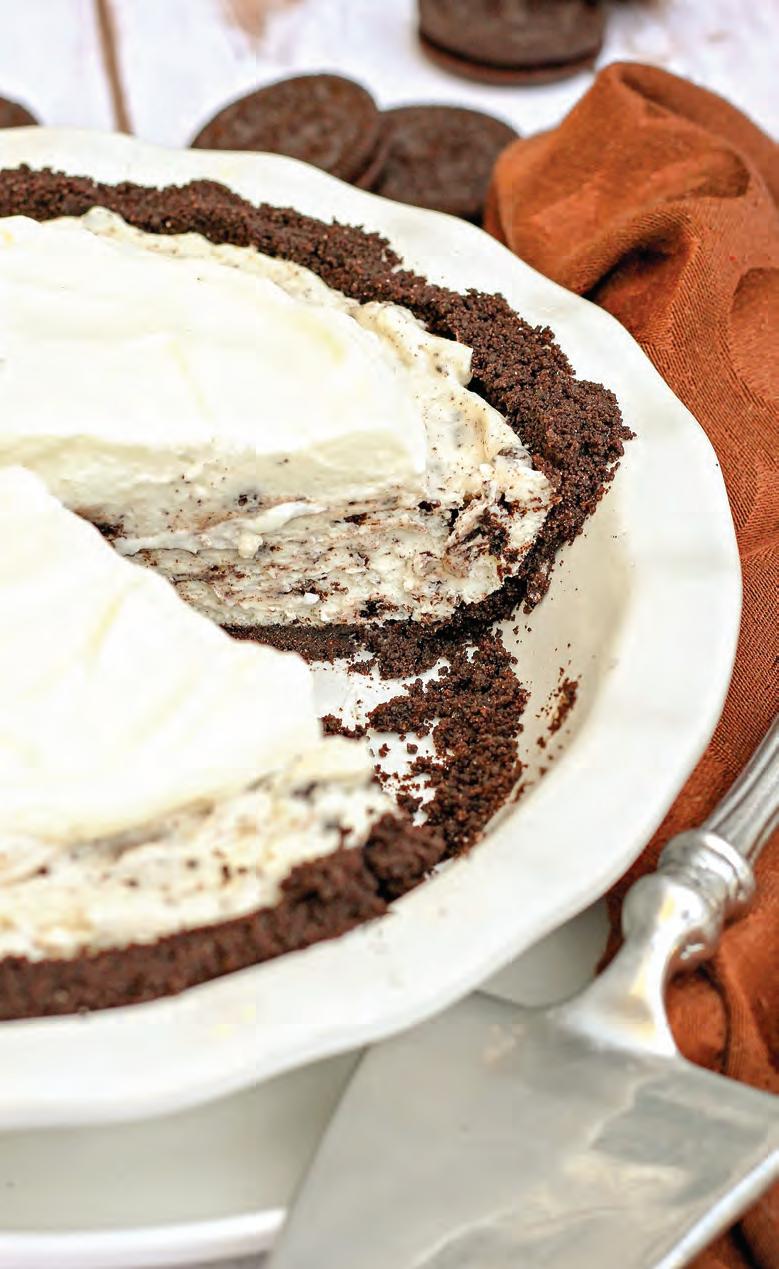
This pie requires an entire package of Oreos –every one of the 24 cookies – but admit that you lack self-control and buy a second bag and save yourself a return trip to the grocery store when you nibble from the first package.
Add Oreos to the bowl of a food processor and pulse until fine crumbs are formed. Stir in melted butter. Press crumbs into a 9-inch pie pan. Bake about 10 minutes at 350°, or until set. Cool completely.
In a large bowl, use an electric mixer to beat cream cheese and marshmallow cream until smooth. In a separate bowl, use electric mixer to beat whipping cream and sugar until soft peaks form. Remove 1 1/2 cups of whipped cream and place in refrigerator. Continue beating remaining cream until stiff peaks form.
Fold stiff whipped cream into cream cheese mixture. Fold in crushed Oreos.
Spread filling into cooled crust. Top with reserve whipped cream. Garnish with an Oreo before serving.
For the crust
24 Oreo cookies
1/4 cup butter, melted
For the filling
1 package (8 oz) cream cheese, softened
1 cup marshmallow creme
2 cups heavy whipping cream
3 Tbsp sugar
12 Oreo cookies, coarsely crushed
Serves 8
We are interested in featuring your favorite family recipes. Send them (and memories inspired by your recipes) to editor@utahlifemag.com.

Utah cowboy culture and ski culture come together for skijoring competitions in Heber City, where horses race at top speed and skiers just try to hold on.

Speed, skills and spills at Skijoring Utah competition

story by COLIN CLANCY
Slim Shady highsteps once with rider Marquise Young on his back, then leaps into a run. In three strides, the former racehorse reaches top speed – 40 miles an hour, accelerating faster than a snowmobile.
Attached to Slim Shady’s saddle is a 50foot chunky cotton rope. At the other end, Scott Hoover holds on with a death grip as he carves his skis and lines up for the first of four jumps. He’ll only have to hold on for 14 seconds – but at the end of the bullwhip, that feels like an eternity.
This is skijoring in Utah: part rodeo, part ski racing and 100 percent wild west spectacle.
For skier Hoover, nothing beats the adrenaline of skijoring, whether he falls or finishes.

“Once that horse takes off and you feel that tension on the rope, it’s just pshh, gametime. You’re in the zone, flying,” he said.
Now in its seventh year, Heber City’s Skijoring Utah has become one of the premier skijoring races in the West. With a total cash purse of $25,000 dollars split between skiers, riders and horses, this event drawn competitors from all over the West.
Hoover, a Midway local, didn’t have far to come for the competition, which keeps him busy on the two-day mid-February race weekend. He races on seven teams in different divisions which gives athletes more chances at the money and championship buckles.
Wearing chaps and a flannel with the words “I Could Do This All Day,” Hoover is all-in on skijoring, even to the extent of making it a family sport. While dashing around for his own races, he coaches
three of his children – 7, 8, and 10 – to compete in the Lil’ Buckaroo Division.
Built on the rodeo grounds of Wasatch County Events Complex in Heber City, the racecourse is a 600-foot drag strip, curving slightly to the left, consisting of four large jumps made of piled snow and ankle-high slalom gates. The fastest combined times of a run Friday night and a run Saturday win each of nine divisions, ranging from Novice to Professional.
Missing gates or jumps results in time penalties, while crashing or dropping a rope knocks teams out of the running. The final gate is the hardest part of the course and is a must-hit, or risk disqualification. The finish comes on the heels of landing a jump, followed by an immediate right slalom turn and then an immediate left – all happening within the final second. Even the best runs finish with the skier wildly off balance across the finish.
“Once that horse takes off and you feel that tension on the rope,

Stadium lights illuminate the course, and snow dumps from the heavens on Friday night. Country music blares through speakers, interrupted by an announcer’s voice hyping the audience in the stands into a frenzy.
The crowd represents a blend of cultures: a Western cowboy aesthetic of fringed leather chaps, gleaming giant belt buckles and dirty felt Stetsons, a mountain town ski look of Gore-Tex and mirrored goggles, and an odd mix of floor-length fur coats, pink bedazzled cowboy hats and brightly colored costumes. Somehow this blend of cultures – this vibe – works in Utah.
Saturday morning dawns bright and brilliant, a chilly 14-degrees. Race officials groomed the course overnight into perfect corduroy. Saturday’s racers will be fast.
At the starting line is first-time skijoring racer, Anna Marno, and her teammate

Celin MacDonald atop a deep brown Warlander named Titan. Marno is a former alpine racer of the U.S. Ski Team. Despite her years in competitive ski racing, skijoring presents its own challenges.
“There’s a lot more to think about,” she said. “The rope, the horse, the jumps, just staying on your feet. All the while, you’re just trying to manage the rope.”
When it’s Marno and MacDonald’s turn, they fly by, ultimately finishing the weekend second in the Novice and Women’s divisions.
The pros come next. Some of the fastest pro skiers don’t appear to be skiing at all – more hanging on and struggling to stay upright. As they barrel down the course, many work their way up the rope, hand over hand, toward the horse – shaving fractions of a second off their time and receiving a spray of snow mere feet from the horses’ flying hooves.
The crowd of 5,000 people hoots and howls with every Pro run. They hoist beers and ring cowbells. These two distinct crowds somehow meld perfectly, encapsulating Skijoring Utah’s mission of merging the state’s ski heritage with its cowboy roots.
Hoover and his teammate, Young, have another run. It’s one of the fastest of the day but not fast enough to win. They place third in this race, a mere fraction of a second behind first place.
Hoover is happy – there’s no time to dwell on it. He hurries back to the starting line with another race to run, and Lil’ Buckaroos to coach.
Former collegiate ski racer Michael Williams (left) keeps control of his skis over a jump during Friday night’s snowfall. Other teams navigate the jumps with mixed results on a fast course Saturday morning, against a backdrop of majestic Mount Timpanogos.
Skier Scott Hoover

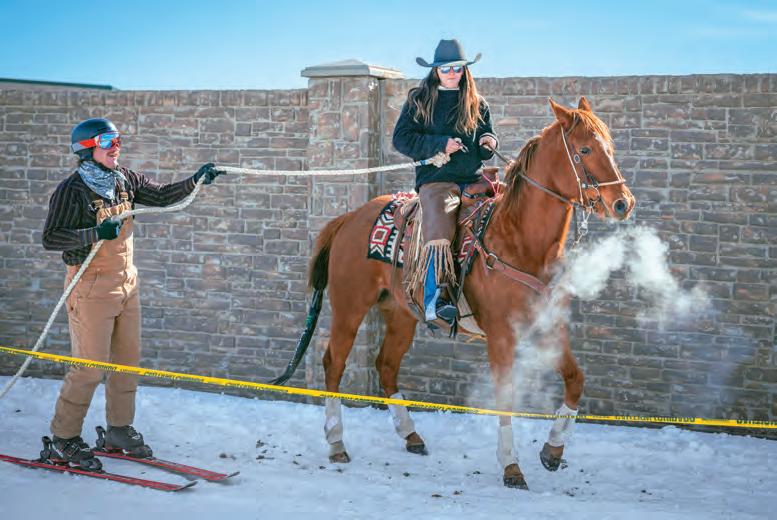
Clockwise from top-left: Skijoring is a little bit country, with a string duo Robin Harper and Dolly Loveridge performing the national anthem. A capacity crowd of cowboys and skiers fills Wasatch County Event Complex. Artist Austin Ratzlaff captures the intensity of the sport live in charcoal. The mix of ranchhand attire and downhill skis is common. After an intense run, athletes including the horses, get a chance for a breather during the slow tow back to the corrals.
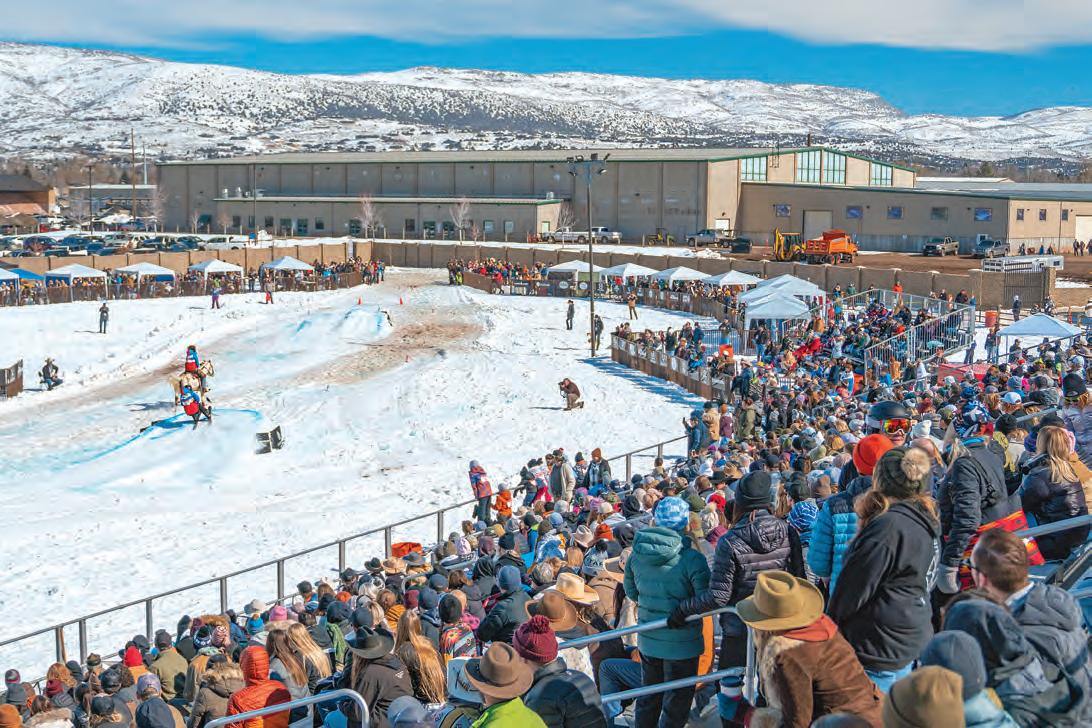



“Celebrating Irish Hospitality” is the theme for the wee-folk-friendly St. Patrick’s Day Parade at The Gateway in Salt
The fifth-century missionary and Irish bishop Saint Patrick, who legend says, brought Christianity to Ireland and banished all the snakes from the island. Celebration of St. Patrick’s Day in the United States dates back to March 17, in 1737, when two dozen immigrants from Northern Ireland gathered to honor the “Apostle of Ireland.”
As the Irish holiday spread across the United States, it eventually reached Utah, and according to Irish historian Gerald McDonough, the first St. Patrick’s Day parade in Utah was held in Sandy in 1864. The popularity for the holiday has grown each year and is now an adored annual tradition.
For 2024, Salt Lake City will turn green and celebrate its unique version of the
holiday. The theme for the festivities this year is “Celebrating Irish Hospitality.”
After the parade, everyone is welcome to Siamsa, pronounced “Sheem-sa,” an Irish word expressing mirth and music. The Celtic-themed celebration includes family-friendly activities such as face-painting, balloon artists, and performing an Irish jig in The Gateway’s main plaza.
The Hibernian Society of Utah sponsors the events. The society and its first parade were impromptu. Four men decided in 1977 to march onto 400 South. The next year, 5,000 people showed up.
Catered Irish fare includes corned beef, Irish stew and baked potato; vendors offer jewelry. irishinutah.org, (801) 599-9065.
MARCH 16, SALT LAKE CITY
A steel sculpture of the Irish Cross stands in Jordan Park, one of 28 nations represented in the International Peace Garden.
1060 S. 900 West
Seven ounces of beef on ciabatta bun are the base of Poplar’s signature series of burgers: Prosciutto, Cuban, Epic, Pastrami and Chorizo.
242 S. 200 West, (801) 532-2715

APRIL 6-7, SALT LAKE CITY
Rio Grande Cafe
Inside the Historic Fire Station No. 8, feast on comfort-food favorites such as chimichangas and halibut tacos. Drinks include margaritas, cocktails and Sarsaparilla.
258 S.1300 East, (801) 364-3302
Ellerbeck Bed & Breakfast
The rooms in this 1892 Victorian mansion have 12-foot ceilings, French doors and chandeliers. Located in the Avenues, the classic neighborhood evokes hints of days gone by.
140 North B St. E., (801) 903-3916
Orchids thrive in the Utah wild, with at least 16 native species in moist higher elevations and valleys. Their colors range from pristine white to deep blue to passion purple. Some species have a fragrance similar to home-baked cookies.
Hike Big Cottonwood Canyon to find native orchids, or better yet, attend the annual Orchid Show in Salt Lake City at the Red Butte Garden. The garden’s sights and smells offer ideas for home gardens. Opening in 1985, Red Butte Garden and Arboretum covers 100 acres at the eastern edge of the University of Utah campus.
Clint Lewis is a board member of the Utah Orchid Society, which hosts the orchid show, and frequently speaks at the annual event. He says people growing orchids at home should remember that they need to water their orchids even after the
blossoms have appeared – tepid water, not ice cubes, as some advise. Moth and slipper orchids grow well in homes.

For newbie horticulturists, the show hosts an open session beginning at 2 p.m. on April 6 on the care of orchids. The April 7 session teaches the methods of repotting orchids. Vendors offer flowers and pottery for purchase. redbuttegarden.org
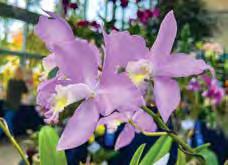





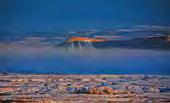

MARCH 28-30, ST. GEORGE
The festival showcases the many talented artists that reside in the area. Cultural enthusiasts will enjoy thousands of original works of art, live entertainment on two stages and great food. Bring the kiddos to play in the lively children’s area. (435) 627-4512
MARCH 29, SYRACUSE
The beauty of Antelope Island and the Great Salt Lake inspires runners at the start of the race at White Rock Trailhead. Participants choose between a 50K or a 50/100 mile run.
buffalorunadventures.com
MOUNTAINS
April 7, Eagle Point Resort, Sundance Resort
April 14, Deer Valley Resort
April 16, Brian Head Resort, Powder Mountain
April 21, Alta Ski Area, Snowbasin
April 28, Park City Mountain
APRIL 20, SALT LAKE CITY
Celebrating its 21st year, the Salt Lake City Marathon passes through Salt Lake City, Millcreek and Holladay. The race begins at the Olympic Legacy Bridge, moves through the city’s center, and ends at Library Square.
saltlakecitymarathon.com
APRIL 25-27, ST. GEORGE
The Red Cliffs Bird Fest showcases the habitat of Greater Zion during spring migration. In the warm spring air, spectators can experience the magnificence of the area, matched only by the beauty of the birds. Field trips combine birding with other outdoor activities for maximum enjoyment and fun.
(435) 767-7617
APRIL 26, PRICE
Hear ye, hear ye! All lords and ladies gather in Washington Park on April 26 for a day of festive frivolity. Dress as an elegant courtier, chivalrous knight or flashy wench. Indulge in food and drink while you delight in archery, ax throwing, stage play, demonstrations and a petting zoo. (435) 637-5010

APRIL 26, MOAB
Hundreds of antique cars and trucks will line up at Swanny City Park, backed by the beauty of Moab. Admission is free, so bring the entire household to this family-friendly festival. (435) 259-7814
Goblin Valley
Hereditary
Payson
Monument Valley
East High School
Ogden

Juan Diego Catholic
School
The Blair Witch
Lehi Roller Mill
Alberta
12 False. The film was almost entirely shot in Utah and California.
13 False. Scenes of Tatooine were filmed in Tunisia. 14 True
15 False. Ralston was trapped in Bluejohn Canyon in Canyonlands National Park.
Trivia Photographs
Hanks in Forrest Gump



















IN EACH ISSUE, Monumental Exposure features a reader’s photograph of Utah – landscapes, architecture, events, people or wildlife. Submit your best shots for the chance to be published in Utah Life. Send digital images with detailed photo descriptions and your contact information to photos@utahlife.com or visit utahlife.com/contribute.
Utah photographer Noah Wetzel set up one of his two tripods in the middle of the day, his camera overlooking Silent City – the name given to hoodoos assembled in Bryce Canyon National Park. The bright red hoodoos had just received a thick blanket of the white stuff. Wetzel had heard the weather report calling for snow, packed for a five-day photography trip, and drove from Salt Lake City, avoiding the rush to the ski slopes. Wetzel snapped six shots of white on red in less than a minute, and later stitched them together into a panorama, producing an image that inspires him to want to go back. What Wetzel loves most about the image is what he calls the benefits of “window shopping,” the patient, time-consuming process of waiting for midday clouds to move into position, sunlight peeking through onto certain spots within his viewfinder. In this image, sunlight lit hoodoos 300 yards directly in front of his position on the Rim Trail, exactly what he had waited for. Wetzel worked hard the whole trip, taking full advantage of the first snow, when he shot the image, and the second that came several days later. He began each day before dawn and stayed until after midnight, getting about four hours’ sleep. Back and forth from his nearby hotel he’d drive, lugging 35 pounds of camera equipment plus food and water to Silent City. He took breaks back at his trunk, cooking veggie dogs on his camp grill. It was January, and frigid, so when Wetzel took time exposure shots in the dark, some lasting 30 minutes, he hiked to stay warm.
“I was completely alone, having an exhausting, meditative experience,” Wetzel said. “That’s what landscape photography is.”

story by KERRY SOPER
illustration by JOSH TALBOT
Persuading people to ski Utah’s slopes is easy: simply describe the joys of fresh powder, the adrenaline rush of bombing down a steep slope, or the vertigo-inducing thrill of floating 100 feet above our Wasatch mountains. If those talking points don’t work, there are lesser-known benefits that don’t get as much airtime. Skiing makes you humble, by humiliating you. No other pastime has a steeper learning curve. When you start out, you’re not technically skiing; you’re performing an interpretive dance, involving lots of lurching, arm-spinning, squatting and high-pitched screaming that you perform for hundreds of strangers.
In everyday life, little kids stay humble through regular exposure to low-grade bullying at school. But what about us smug middle-aged folks? Learning to ski
at an expensive resort can serve that same purpose. You will endure a mental wedgie when younger, better skiers laugh and point at you, like patrons at an outdoor comedy show. Nothing looks funnier to Gen Z snowboarders than fools in their 40s with minimal leg strength (and gradually diminishing self-worth) repeatedly snowplowing into each other at high speeds.
Second, skiing makes you more physically fit. Not from skiing, of course. Ninety percent of your time pursuing this sport is spent waiting in lines: at ticket windows; at the base of a lift; or in your car, behind an endless stream of other vehicles. No, physical fitness comes from your exertions beforehand, in getting ready to go skiing. Consider the incredible workout your core gets from just trying to put on ski boots. You’ll crunch your abs and strain your lumbar region for a full 15 futile minutes. Meanwhile, you’ll sweat like it’s hot yoga, and burn a ton of calories from all
the weeping, swearing and finger-pinching. And if you have little kids who need help getting their boots on as well? That’ll set your neglected glutes on fire.
For a great cardio workout, all you have to do is walk from your car to the lifts, across a 200-yard parking lot, while wearing those clunky, 50-pound boots and carrying a ton of complicated gear: 8-foot-long skis that keep sliding apart and pinching your fingers; aluminum poles that tend to get wedged in your crotch; and an array of goggles, helmets and gloves that you’ll drop and pick up seven times. It’s the most sadistic (but weirdly mundane) CrossFit work out of all time, with the bonus of taking place on dirty ice.
Skiing makes you good at math and solving puzzles. You thought story problems in 8th grade were hard? Consider this head scratcher: “If John buys an IKON season pass, thinking that he’s saving $1,500, but IKON is invalid precisely on his days off,
how many times will he need to buy $200 day passes before defaulting on his student loans?”
You’ll pay, but no one will give you instructions about getting on and off a ski lift, even though you will need the skills of a professional, synchronized swimmer (but with the mobility of a mummy who has giant boards attached to its feet) to pull it off effectively. The stakes feel bracingly high too, like getting a single step or half-squat wrong will result in you being catapulted into a pine tree, or causing the entire resort to shut down as they dig you out of a 30-foot-deep snow angel.
If you do make it on to the slopes, you’ll then need to decode a set of cryptic, geometric shapes: colored circles, squares and diamonds that seem to lead you arbitrarily to either a “bunny slope,” or a 500-foot drop off with an inappropriate name like “Mountain Meadows Moshpit.” Resort designers could have made it easy, of course, using familiar images that have inherent meaning to the human brain, like a marshmallow for “easy,” or a glowing, red pentagram for “life-threatening.” But I guess that would have been too simple.
Finally, skiing acts as a snowy crucible that tests family relationships. Maybe it’s the combination of cold temperatures, prohibitive cost, excessive gear and extreme difficulty that gives it that unique, stressful power to either strengthen or destroy family bonds. I’ve seen the full range of comedy, drama and tragedy on Utah’s slopes: an engagement imploding because an overconfident guy lost patience with his girlfriend’s snowplowing ability and went off to ski for the rest of the day on his own; a 10-year-old girl comforting her walrus-sized dad who just blew his knee out trying to snowboard for the first time; and a mom having an understandable meltdown in the parking lot over her 12-year-old son losing his fifth pair of gloves in a single season.
My own kids – who were taught to ski haphazardly by me and some well-meaning aunts and uncles across several traumatic winters – can’t decide if our days on the Utah slopes as a family were some of their favorite childhood memories, or triggers for long-term therapy (therapy they’ll need to postpone for another decade if they want to purchase season passes again this year).
